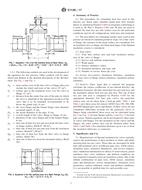Potřebujeme váš souhlas k využití jednotlivých dat, aby se vám mimo jiné mohly ukazovat informace týkající se vašich zájmů. Souhlas udělíte kliknutím na tlačítko „OK“.
ASTM C1129-17
Standard Practice for Estimation of Heat Savings by Adding Thermal Insulation to Bare Valves and Flanges
Přeložit název
NORMA vydána dne 1.3.2017
Informace o normě:
Označení normy: ASTM C1129-17
Datum vydání normy: 1.3.2017
Kód zboží: NS-677467
Počet stran: 8
Přibližná hmotnost: 24 g (0.05 liber)
Země: Americká technická norma
Kategorie: Technické normy ASTM
Kategorie - podobné normy:
Anotace textu normy ASTM C1129-17 :
Keywords:
calculated energy savings, flanges, heat loss, heat loss from pipes, pipe systems , valves,, ICS Number Code 23.040.60 (Flanges, couplings and joints)
Doplňující informace
| Significance and Use | ||||||||||||
|
5.1 Manufacturers of thermal insulation for valves typically express the performance of their products in charts and tables showing heat loss per valve. These data are presented for both bare and insulated valves of different pipe sizes, ANSI classes, insulation types, insulation thicknesses, and service temperatures. Additional information on effects of wind velocity, jacket emittance, bare valve emittance, and ambient conditions are also required to properly select an insulation system. Due to the infinite combination of pipe sizes, ANSI classes, insulation types and thicknesses, service temperatures, insulation cover geometries, surface emittance values, and ambient conditions, it is not possible to publish data for each possible case. 5.2 Users of thermal insulation for piping systems faced with the problem of designing large systems of insulated piping, encounter substantial engineering costs to obtain the required thermal information. This cost can be substantially reduced by both the use of accurate engineering data tables, or by the use of available computer analysis tools, or both. 5.3 The use of this practice by the manufacturer, contractor, and users of thermal insulation for valves and flanges will provide standardized engineering data of sufficient accuracy and consistency for predicting the savings in heating energy use by insulating bare valves and flanges. 5.4 Computers are now readily available to most producers and consumers of thermal insulation to permit use of this practice. 5.5 The computer program in Practice C680 has been developed to calculate the heat loss per unit length, or per unit surface area, of both bare and insulated pipe. With values for bare valve or flange surface areas, heat loss can be estimated. By estimating the outer insulation surface area from an insulation manufacturer's or contractor's drawings, the heat loss from the insulation surface can likewise be calculated by taking the product of heat loss per unit area (from programs conforming to Practice C680) and the valve or flange insulation surface area. The area of the uninsulated surfaces also will need to be considered. 5.6 The use of this practice requires that the valve or flange insulation system meets either Specification C1695 for removeable/reuseable or the Adjunct to Practice C4503 for insulation fabricated from rigid board and pipe insulation. |
||||||||||||
| 1. Scope | ||||||||||||
|
1.1 The mathematical methods included in this practice provide a calculational procedure for estimating heat loss or heat savings when thermal insulation is added to bare valves and flanges. 1.2 Questions of applicability to real systems should be resolved by qualified personnel familiar with insulation systems design and analysis. 1.3 Estimated accuracy is limited by the following: 1.3.1 The range and quality of the physical property data for the insulation materials and system, 1.3.2 The accuracy of the methodology used in calculation of the bare valve and insulation surface areas, and the quality of workmanship, fabrication, and installation. 1.4 This procedure is considered applicable both for conventional-type insulation systems and for removable/reuseable covers. In both cases, for purposes of heat transfer calculations, the insulation system is assumed to be homogenous. 1.5 This practice does not intend to establish the criteria required in the design of the equipment over which thermal insulation is used, nor does this practice establish or recommend the applicability of thermal insulation over all surfaces. 1.6 The values stated in inch-pound units are to be regarded as standard. The values given in parentheses are mathematical conversions to SI units that are provided for information only and are not considered standard. 1.7 This standard does not purport to address all of the safety concerns, if any, associated with its use. It is the responsibility of the user of this standard to establish appropriate safety and health practices and determine the applicability of regulatory limitations prior to use. |
||||||||||||
| 2. Referenced Documents | ||||||||||||
|




 Cookies
Cookies
